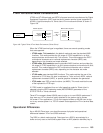
pressed. An AID key on a 5250 keyboard is a key that initiates a function. The
following are the AID keys on a 5250 keyboard:
v Clear
v Command Function 1 through 24
v Enter/Rec Adv
v Help
v Print
v Record Backspace Function
v Roll Down (Page Up)
v Roll Up (Page Down)
VTxxx terminals operate in a character mode. Characters are sent immediately to
the host when a key is pressed.
Another difference is the way the data arrives on the display. Data is written to a
VTxxx terminal one character at a time, and you see the data arrive as streams of
characters. With the 5250, data is written in blocks, and all or part of the display
changes at once.
Keyboard Issues
You should avoid using the 5250 cursor movement keys. Instead, you should use
the function keys associated with the *CSRUP, *CSRDOWN, *CSRRIGHT, and
*CSRLEFT keywords. By default these are keys F13, F14, F15 and F16
respectively. If you use the 5250 cursor movement keys, the VTxxx application you
are using may not function as expected because the results of using these keys are
not transmitted to the remote system until an attention identifier (AID) key is
pressed.
For example, using Telnet to the RISC System/6000 and obtaining VT220
emulation, the SMIT command provides a menu driven interface to AIX. Here the
function keys associated with *CSRxx keywords perform as you would expect the
cursor movement keys to do. However, the 5250 cursor movement keys, while
physically moving the cursor down the screen and correctly selecting the SMIT
option, do not cause the selected option to be highlighted. The highlighting in
reverse video remains with the first option on the SMIT menu, regardless of the key
position.
Typing a control character on an AS/400 keyboard is different than typing a control
character on an actual VTxxx terminal. On a VTxxx terminal, the control key is
pressed and held down while the character associated with the control function is
pressed. For example, the VTxxx Control-C function is entered by pressing the
following key sequence:
When using the AS/400 Telnet support, the equivalent is achieved by typing a
two-character control indicator followed by pressing the function key associated with
the *SENDWOCR (Send without Carriage Return) default function (the F11 key).
RV2H015-1
CTRL
C
Figure 107. VTxxx Control-C Sequence
164 OS/400 TCP/IP Configuration and Reference V4R4


















